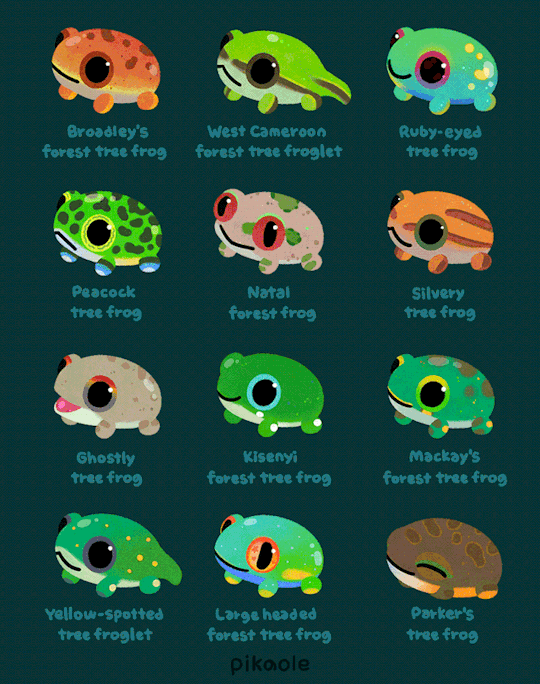Text
Karpathos Frog
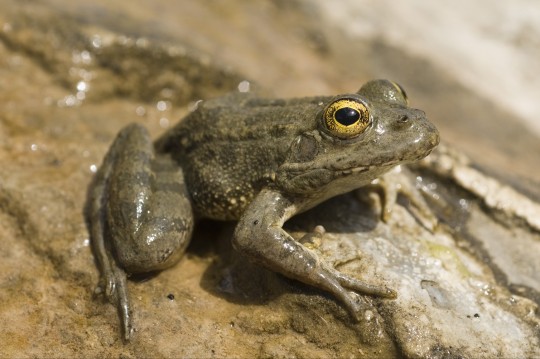
AKA Pelophylax cerigensis
I saw this guy and I just had to cover him!
These guys were once considered to be the most endangered species of frog in europe, because they were found only in two small rivers in the island of Karpathos. Later they found out there's more of them in the island of Rhodes! They're still considered endangered, but not nearly as much as before. One hop at a time!
0 notes
Text
Gray Treefrog
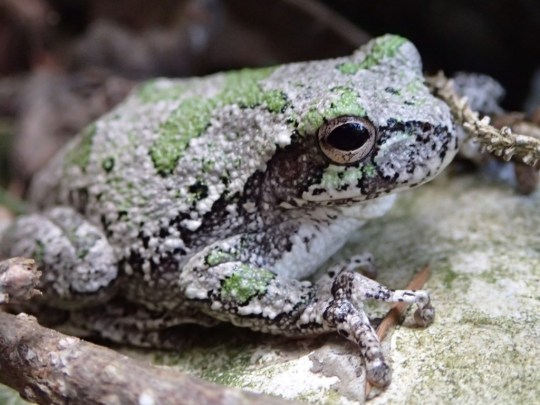
AKA Eastern Gray Treefrog, Northern Gray Treefrog, Common Gray Treefrog, Tetraploid Gray Treefrog, Dryophytes versicolor
These rock-looking guys live all over eastern North America! They can change their color like chameleons, from near black to near white to brown or green or gray! So calling them 'Gray' Treefrogs is only accurate some of the time!
They're found of sitting near windows and lights to snatch up any insects that come check out the lights. Very crafty! Though if the opportunity arises, they'll even eat other frogs!
They are very similar to Cope's Gray Treefrogs, but have different calls as well as twice as many chromosomes!!
1 note
·
View note
Text
Karpathos Frog
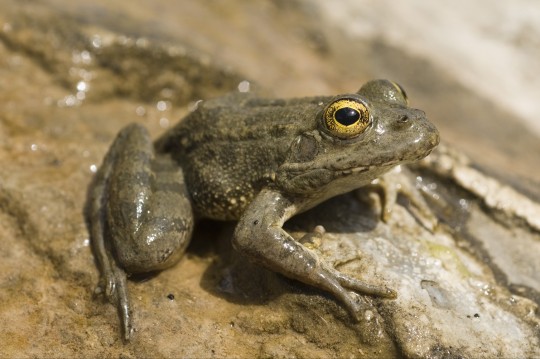
AKA Pelophylax cerigensis
I saw this guy and I just had to cover him!
These guys were once considered to be the most endangered species of frog in europe, because they were found only in two small rivers in the island of Karpathos. Later they found out there's more of them in the island of Rhodes! They're still considered endangered, but not nearly as much as before. One hop at a time!
0 notes
Text
Granular Toad

AKA Common Lesser Toad, Rhinella granulosa
Common lesser toad??? So mean to him!!
Granular toads are called that because their skin looks very grainy! They spend the day burrowed up in holes, and leave at night to hunt and mate! Their most common meals are ants and termites.
The Rhinella genus was originally grouped with Bufo, which was a catch-all for frogs that didn't fit anywhere! In 2009, many frogs were reclassified, so Bufo granulosus became Rhinella granulosa!
1 note
·
View note
Text
Mottled Shovelnose Frog

AKA Marbled Shovelnose Frog, Marbled Snout-Burrower, Hemisus marmoratus
Funny-looking guys from southern Africa that can live in a wide variety of habitats!
They use their hard pointy faces to dig! When they're ready to mate, they use their noses to dig tunnels, where the female stays until there's enough rainfall. When that happens, she digs her way back up and releases the eggs into the water!
Mottled/Marbled shovelnose frogs in particular are named for their skin pattern, which varies a lot from frog to frog! Some are more brown-ish, some more yellow-ish!
#frogs#brown frogs#patterned frogs#african frogs#mottled shovelnose frog#marbled shovelnose frog#hemisus marmoratus
2 notes
·
View notes
Text
Peter's Foam-Nest Frog
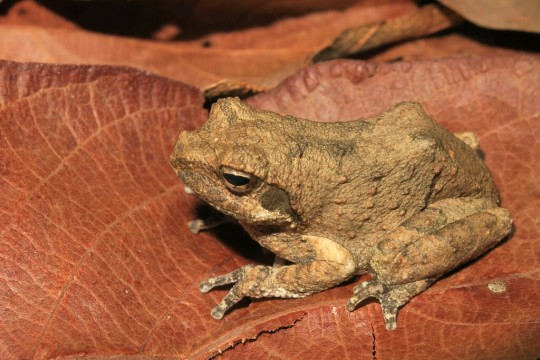
AKA Peter's Foam-Nest Tree Frog, Central Foam-Nest Tree Frog, Chiromantis petersii
Very regal!! These guys live in the east of Africa, in very arid regions. Because they live in regions with little rain, they put their eggs in temporary pools! Their toes have less webbing than most frogs, because they don't got many places to make use of it.
Some of them are a pretty standard brown, while others are a marble-like gray! They do mating calls, but they're a pretty quiet croaking! I tried to find any recordings but didn't get anything :(
A similar type of frog, the Keller's Foam-Nest Frog, was originally considered a subspecies, but they were later recognized as their own thing!! Hooray for independence!
#frogs#brown frogs#gray frogs#african frogs#peter's foam-nest frog#peter's foam-nest tree frog#central foam-nest tree frog#chiromantis petersii
0 notes
Text
Iberian Midwife Toad
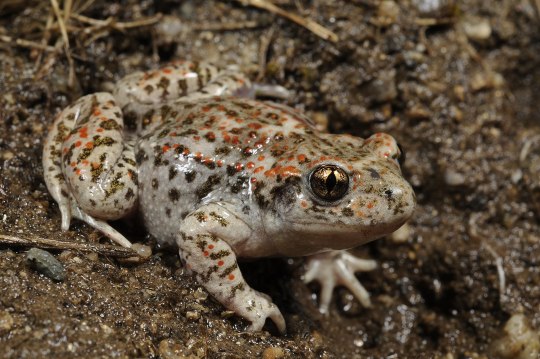
AKA brown midwife toad, Alytes cisternasii
Look at these gorgeous little guys!
These iberian frogs have distinctive reddish spots that I quite like! They live near shrubs and oak trees.
Midwife frogs have very distinctive reproduction! The females lay eggs on land, then the males gather them up and carry them like little sashes around their legs, depositing them in the water when they're ready to hatch!
Besides the usual environmental destruction problem, their tadpoles are threatened by invasive species of fish and crayfish. It's not easy being a tadpole, even when your dad cared for you as an egg!
#frogs#brown frogs#multicolored frogs#european frogs#iberian midwife toad#brown midwife toad#alytes cisternasii
1 note
·
View note
Text
Nongkhor Asian Tree Frog
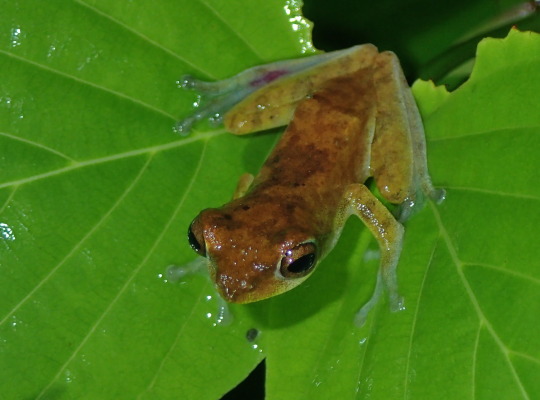
AKA Nongkhor pigmy tree frog, Nongkhor bush frog, Nongkhor foam-nest tree frog, Chirixalus nongkhorensis
Nongkhor asian tree frogs live in forests ranging from eastern India to Vietnam and Malaysia! Those forests are currently threatened, but the frogs are doing their best to adapt!
They're part of the family of foam-nest frogs, which use their legs to create little foam nests under leaves and lay their eggs there; once the eggs hatch, they drop into the water!
#frogs#asian frogs#brown frogs#yellow frogs#nonkhor asian tree frog#nongkhor pigmy tree frog#nongkhor bush frog#nongkhor foam-nest tree frog#chirixalus nongkhorensis
2 notes
·
View notes
Text
Spring Peeper

AKA Pseudacris crucifer
Spring peepers are a type of chorus frog native to eastern North America! Chorus frogs are named that because of the sound they make, a trill like the sound of locusts! For spring peepers in particular get their name because they make those sounds at the beginning of spring. Which, presumably, they can peep coming!
But that's not all that's interesting about spring peepers! They can also survive below-freezing temperatures, because their organs are prepared to go dormant until things warm up again. And when it gets warmer, they increase their chirping and mating!
Females choose males based on their chirping, and some males instead go for a "satellite" strategy where they hang out near males with good chirps to get with any females that approach them. Truly on that satellite male grindset!
Their scientific name crucifer means cross-bearer, because many have cross-like markings on their sides. Truly, peeping spring is a heavy cross to bear! Or to frog I guess.
6 notes
·
View notes
Text
Frogs Big and Small!

I decided to make a simple to-scale collage of the smallest frog species, the Brazilian Flea Toad, and the biggest one, the Goliath Frog!
11 notes
·
View notes
Text
Mountain Chicken
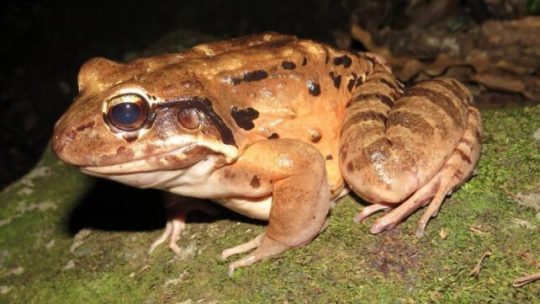
AKA giant ditch frog, crapaud, Leptodactylus fallax
Surprised by the name? These frogs are called "Mountain Chicken" because people love to eat them, and because they supposedly taste like chicken!
These frogs are native to two Caribbean islands, but there's very few remaining in the wild because people love to eat them so much, and on top of it all there's now also a fungal disease attacking them!!
They're pretty big, the largest frogs in the Caribbean and in their family, and can weigh up to 1kg! It's so big it can even eat snakes, bats, or other frogs!
Another unusual thing about them is their reproduction! They nest in little burrows instead of laying eggs in the water!
#frogs#ditch frogs#caribbean frogs#brown frogs#mountain chicken#giant ditch frog#leptodactylus fallax
8 notes
·
View notes
Text
feel free to ask me to cover specific frogs!
1 note
·
View note
Note
do you have a favorite frog
that's like asking me about my favorite child!!
in all seriousness though. we don't have a specific favorite frog but we do have several we like
we've got a weak spot for any amazonian frog (which is so so many of them). we also love tree frogs, specially the extra-froggy wiry green ones, like red-eyes tree frogs. we also love tomato frogs, glass frogs, and mountain chickens!
5 notes
·
View notes
Text
Namaqua Rain Frog
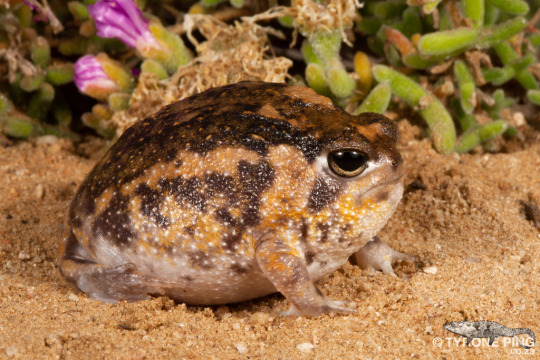
AKA namaqua short-headed frog, Breviceps namaquensis
A round little fellow!
These guys live in Namaqualand and Namibia, in southern Africa. Their toes aren't webbed, and they spend most of their time underground, only coming out after it rains to look for tasty insects.
When threatened, they squeak and inflate to deter predators! I don't think I'd be deterred at all, they're such little cuties!
When they lay eggs, they cover them up in thick yolk-y fluid and the tadpoles live there until grown. Interesting tactic, that.
#frogs#rain frogs#african frogs#brown frogs#namaqua rain frog#namaqua short-headed frog#breviceps namaquensis
18 notes
·
View notes
Text
Amazon River Frog
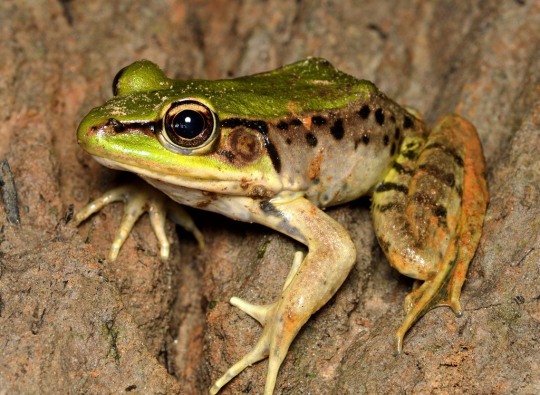
AKA rana verde verdadera (true green frog), Lithobates palmipes
Amazon river frog! They live in the Amazon, and they live near rivers! They don't really live in rivers or only in the Amazon though.
They have very funky marking patterns! They're also appreciated as a snack by the Ye'kwana!
#frogs#river frogs#south american frogs#green frogs#multicolored frogs#amazon river frog#rana verde verdadera#lithobates palmipes
3 notes
·
View notes
Text
Amazon Milk Frog
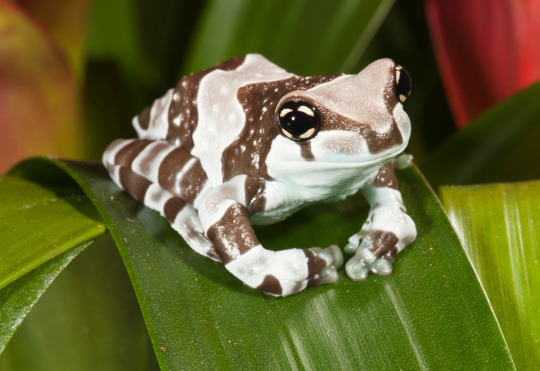
AKA Mission Golden-Eyed Tree Frog, Blue Milk Frog, Trachycephalus resinifictrix
A buddy from the Amazon rainforest!
These zebra-y buddies produce milk when stressed, and are on the large side, getting up to 4 inches! They often live in vegetation sitting above water, such as a tree with branches over a river.
They have blue blood, and you can see some blue when they open their mouths! So regal!
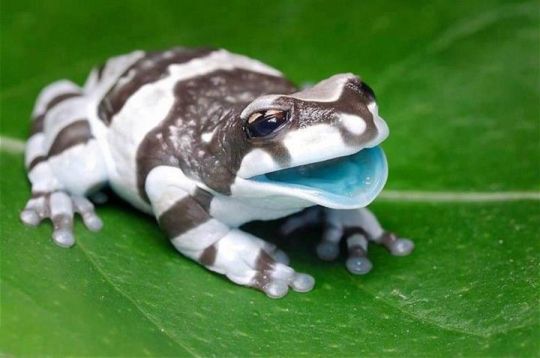
#frogs#south american frogs#nondescript color frogs#multicolored frogs#amazon milk frog#mission golden-eyed tree frog#blue milk frog#trachycephalus resinifictrix
16 notes
·
View notes
